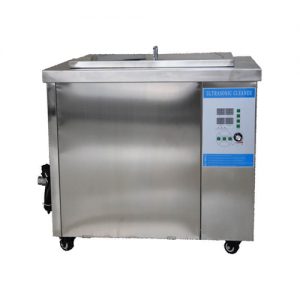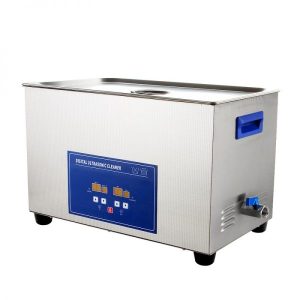The ultrasonic cleaning (USC) is a kind of unique technology for high-quality cleaning. It functions directly or indirectly on the liquid and dirt by making use of the cavitation, acceleration and direct inflow action of ultrasonic in the liquid, making the dirt layer disperse, emulsify and strip to achieve the purpose of cleaning. Among them, the cavitation and direct inflow are more widely used in current ultrasonic cleaners.

What is an Ultrasonic Cleaner?
An ultrasonic cleaner, or ultrasonic cleaning machine, refers to a device that makes use of ultrasonic wave to clean surfaces of objects, such as electronic products, lab supplies, office supplies, household supplies, and other objects. The ultrasonic wave is a kind of sound wave that transcends the auditory frequency of human ears (20Hz-20KHz). Due to the transmission ability of sound in the air is much weaker than that in a liquid, it’s required that cleaning objects by ultrasonic need to use liquids, such as clean water, as mediums. Generally, all ultrasonic cleaners will deign a sink for placing objects and injecting water. The ultrasonic vibration can lead to the phenomenon of cavitation in the water, thus generating countless tiny bubbles. These bubbles will burst rapidly to produce instantaneous high pressure (IHP), which will generate ultrasonic vibration to make dirt on the surface of objects fall off.
What can be Cleaned in an Ultrasonic Cleaner?
An ultrasonic cleaner can be widely used in many fields for cleaning a great variety of objects. For example, it can be used in electronic stores, industrial and mining enterprises, laboratories, hospitals, watch shops, optical shops, jewelry stores, mobile phone repair shops, homes, etc. So a quite wide range of objects can be cleaned by an ultrasonic cleaner, such as electronic products, lab supplies, office supplies, household supplies, motherboard and accessories of computers, glassware, circuit boards, automotive accessories, hardware accessories, medical equipment, dentures and dental equipment, watches, glasses, jewelry, golf, razors, coins, badges, cutlery, bottles, fruits, etc.
What can You not Put in an Ultrasonic Cleaner?
There are only two main categories of objects which can’t be cleaned by an ultrasonic cleaner. The objects that will be damaged by immersion can’t be cleaned by an ultrasonic cleaner, because the ultrasonic cleaning only occurs in the liquid environment. And the objects that can’t be easily dried shouldn’t be cleaned by an ultrasonic cleaner as well, because these objects are generally absorbent.

What is the Best Solution to Use in an Ultrasonic Cleaner?
Many solutions can be used in an ultrasonic cleaner, such as acidic (low pH), alkaline (high pH), neutral, high caustic and enzymatic solutions. They can bond to and remove specific contaminants. Many people may wonder what the best solution among them. There is no absolute answer. The best solution depends on what kind of dirt is being removed.
The acidic solution is suitable for removing lime deposits, scale, rust, and mineral from ferrous metals. The alkaline is more suitable for cleaning tin, brass, zinc, copper, stainless, steel, cast iron, and steel. The neutral solutions are better for cleaning pigments, grease, dust, and other organic compounds. The high caustic solutions are more applicable for removing heavy waxes, oils, and grease from steel, cast iron, and stainless steel. And the enzymatic solutions are more suitable for removing protein-based contaminants from plastics, glass, aluminum, brass, titanium, and stainless steel. The best solution can be chosen based on the objects that need to clean.
What is Cavitation in Ultrasonic?
The cavitaion effect means that ultrasonic transmits to liquid by means of high frequency transmission mode of compression force and decompression force interaction over 20,000 times per second. Under the function of decompression force, the phenomenon of vacuum nuclear group bubbles is generated in the liquid. Under the function of compression force, The vacuum nuclear group bubble can generate a strong impact force when it is crushed under pressure so that the dirt on the surface of the object to achieve the purpose of precise cleaning.
[title text=”Related Products” tag_name=”h2″ color=”rgba(32, 163, 219, 0.81)”]
[ux_products columns=”2″ ids=”3032″]
[title text=”Related Posts” tag_name=”h2″ color=”rgba(32, 163, 219, 0.81)”]
https://www.rotovap.cn/rotary-evaporator/2365.html
https://www.rotovap.cn/rotary-evaporator/1221.html
https://www.rotovap.cn/rotary-evaporator/1440.html
